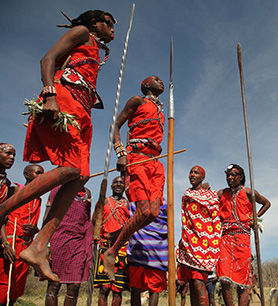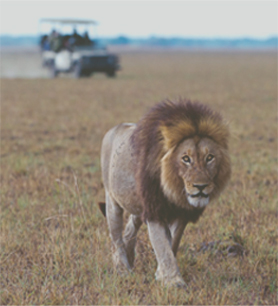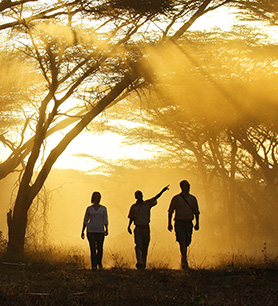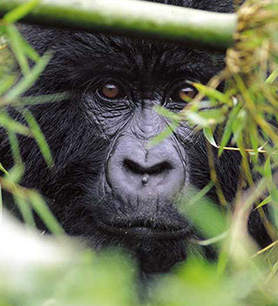Widely regarded as one of the most beautiful natural spectacles in the world, the great wildebeest migration takes place between Kenya and Tanzania, within the Serengeti-Mara ecosystem, where every year two million herbivores, mainly wildebeests and zebras, embark on an epic journey in search of water and fresh pastures.
The protagonists
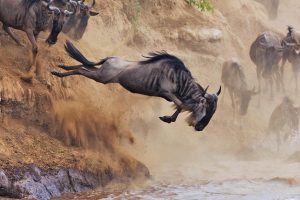 This incredible migration involves between 1,5 and 2 million of wildebeests, zebras, Thomson’s gazelles, elands and other antelope species that annually travel for about a 1,000 kilometres, moving in a clockwise direction, across the plains of Serengeti-Mara, between Kenya and Tanzania. It is the largest terrestrial migration on the planet.
This incredible migration involves between 1,5 and 2 million of wildebeests, zebras, Thomson’s gazelles, elands and other antelope species that annually travel for about a 1,000 kilometres, moving in a clockwise direction, across the plains of Serengeti-Mara, between Kenya and Tanzania. It is the largest terrestrial migration on the planet.
The great migration is a sure phenomenon, which takes place every year, but it is unpredictable by nature.
The number, the direction of movements and the position of the herds in a certain period of the year change according to several factors, including seasonality and, in particular, the distribution of the rains, which are the real engine of the migration.
In fact, the wildebeests, the main protagonists of this migration, are social, water-depending and grazer, so they move in herds constantly looking for fresh and nutrient-rich pastures, regenerated by seasonal rains.
The need to feed, and also to defend themselves against predators, drives the wildebeests even to “go against their nature”, giving up with their territorial habits to migrate and with their social and hierarchical structure to aggregate in herds without a leader, very numerous and often mixed.
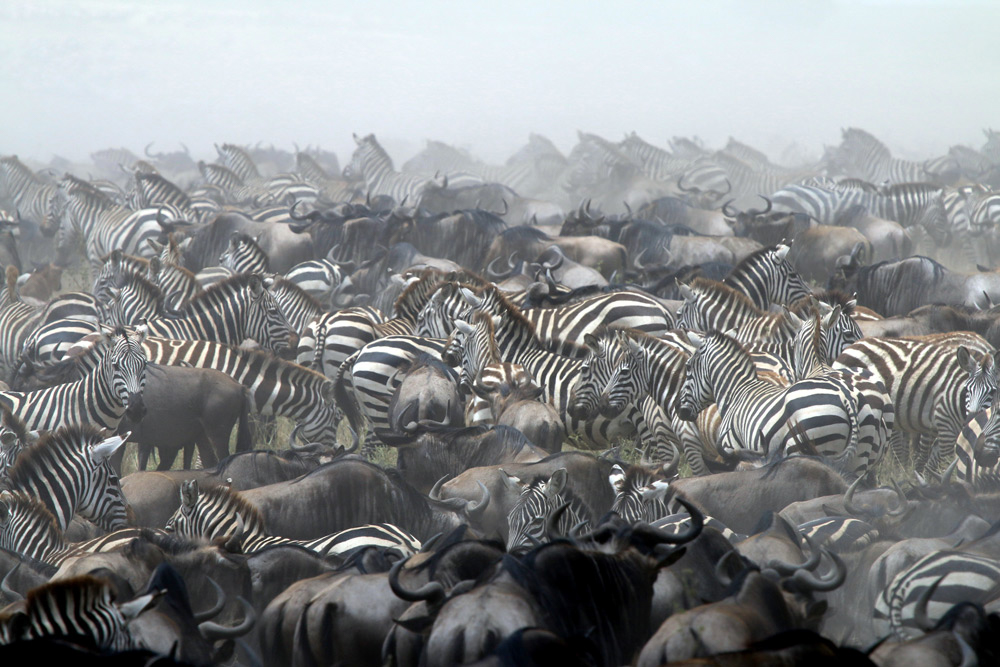 Wildebeest and zebras, in particular, establish forms of cooperation inspired by survival. The two species take turns in the pasture: zebras graze the highest grass and “prepare” the pasture for the wildebeests, who prefer lower and softer grass. Furthermore, to defend themselves against predators, the wildebeests take advantage of the best sight of zebras and both species take advantage of their number.
Wildebeest and zebras, in particular, establish forms of cooperation inspired by survival. The two species take turns in the pasture: zebras graze the highest grass and “prepare” the pasture for the wildebeests, who prefer lower and softer grass. Furthermore, to defend themselves against predators, the wildebeests take advantage of the best sight of zebras and both species take advantage of their number.
The fight for survival triggers the migration and the rains drive it. In order to survive the wildebeest have to follow the rain, and the water and the food that come with it, and to do that they are prepared to do anything: they challenge lions, cheetahs and hyenas in the plains, they wade through turbulent crocodile-infested rivers, they fight hunger, thirst, fatigue and diseases, and each year they die in a number of 250,000 along the way.
If the “why” of the great migration and what drives the wildebeests to embark on this odyssey is not in question, there are still many unanswered questions about “how” the migration works.
How does the great migration work?
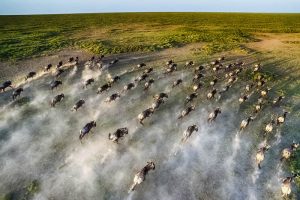 How does a herd of thousands wildebeest move and orientate? And before that, what happens in the plains of southern Serengeti, in mid-March, when the first wildebeest stands up and starts to move? What does that wildebeest feel? What draws him?
How does a herd of thousands wildebeest move and orientate? And before that, what happens in the plains of southern Serengeti, in mid-March, when the first wildebeest stands up and starts to move? What does that wildebeest feel? What draws him?
Studies using aerial photography show a remarkable level of organization in the structure of the wildebeest herds as they move. The herds display a compact and winding front, just like a wave. Is there some sort of leadership within the herd? Or maybe a form of communication we don’t know yet?
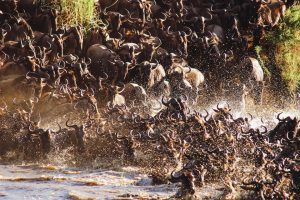 A research has also shown that a wildebeest herd has the so-called “swarm intelligence”, a sort of collective intelligence, typical of swarms of insects or flocks of birds, which allows it to explore and overcome an obstacle as a unit or, in fact, like a swarm. In this view the rivers crossing would not then be so chaotic and disorganized as it appears.
A research has also shown that a wildebeest herd has the so-called “swarm intelligence”, a sort of collective intelligence, typical of swarms of insects or flocks of birds, which allows it to explore and overcome an obstacle as a unit or, in fact, like a swarm. In this view the rivers crossing would not then be so chaotic and disorganized as it appears.
It has also been proven that wildebeests are able to locate rain more than 50 kilometers away. How? They see the clouds or lightnings on the horizon? They can hear the thunders? They smell the humidity in the air? Some scientists believe that wildebeests are attracted by the chemistry of the grass, namely higher levels of phosphorus and nitrogen, which change in response to the rains. So maybe wildebeests just follow their taste.
Or it could simply be instinct. Fossil evidence suggests that wildebeests have been living and moving in the plains of East Africa for over one million years.
The origins of the phenomenon
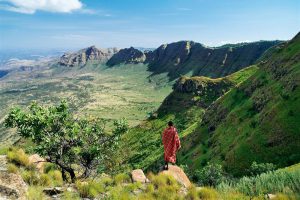 The phenomenon of the great wildebeest migration has its roots in a distant time and it is linked to events that occurred about 25 million years ago.
The phenomenon of the great wildebeest migration has its roots in a distant time and it is linked to events that occurred about 25 million years ago.
At that time started the formation of the Great Rift Valley, a gigantic fault in the earth’s surface, about 6,000 kilometers long, which runs from Lebanon to Mozambique and it was caused by the separation of the Arab and African tectonic plates. The resulting seismic and volcanic activity gave rise to numerous mountains such as Mount Kilimanjaro and Mount Kenya.
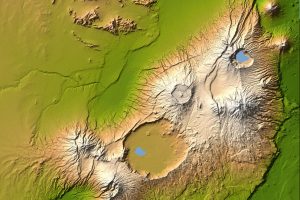 For million years the seven volcanoes of the Ngorongoro complex and the Ol Doinyo Lengai volcano, today the only one still active, erupted rocks, lava and ash rich in minerals that fertilized the Serengeti plains.
For million years the seven volcanoes of the Ngorongoro complex and the Ol Doinyo Lengai volcano, today the only one still active, erupted rocks, lava and ash rich in minerals that fertilized the Serengeti plains.
In fact, when volcanic ash mixes with the earth, the result is a fertile soil rich in phosphates, nitrates, potassium, sodium and calcium, all elements which support the growth of rich and nutritious vegetation.
This volcanic soil, rich in minerals and nutrients, is the base of the grassy plains of Maasai Mara and Serengeti, which the wildebeests cross following the rains and exploit to their advantage from millennia.
The circle of life
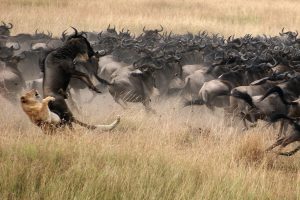 The Serengeti-Mara ecosystem is one of the oldest in the world, it covers 40,000 square kilometers between the Serengeti National Park in Tanzania and the Maasai Mara National Reserve in Kenya, and boasts a diversity of flora and fauna that has no equal in the world.
The Serengeti-Mara ecosystem is one of the oldest in the world, it covers 40,000 square kilometers between the Serengeti National Park in Tanzania and the Maasai Mara National Reserve in Kenya, and boasts a diversity of flora and fauna that has no equal in the world.
It is estimated that during the great migration nearly 1.5 million tons of grass are consumed each year and, thanks to the generosity of nature, they return to the earth in the form of dung. This dung is added to the mineral soil of the Serengeti, mixed by thousands of hooves, fertilized by dung beetles and watered by rain. The result is over 200 types of herbs, each with its own function.
During the migration the herds are continuously threatened by predators such as lions, leopards, cheetahs, hyenas, jackals and crocodiles. The wildebeests death sustains directly these predators, but also indirectly feeds other creatures.
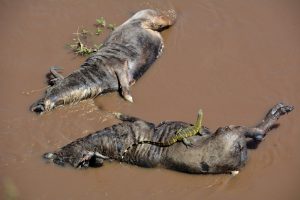 During the migration the wildebeest herds are forced to cross insidious rivers like the Grumeti and the Mara. A hurricane of horns and hooves, shrouded in dust, pours into the water: many wildebeests manage to reach the other side, but thousands die because of the crocodiles, of the blows and fractures in the impact with rocks and other wildebeests or simply of the too strong current.
During the migration the wildebeest herds are forced to cross insidious rivers like the Grumeti and the Mara. A hurricane of horns and hooves, shrouded in dust, pours into the water: many wildebeests manage to reach the other side, but thousands die because of the crocodiles, of the blows and fractures in the impact with rocks and other wildebeests or simply of the too strong current.
A long study on the influence of large animals on the processes in progress in the Mara River ecosystem revealed that 6,250 carcasses, equivalent to 1,100 tons of biomass, enter the river every year.
The bodies accumulate and the carcasses become food for hyenas, crocodiles, vultures and marabu. The remains decompose and the insects lay their eggs inside, feeding mongooses, ibis and other birds. Even the river fish take part in the banquet.
Thus the circle of life closes, a perfect circle in which everything is created and nothing is destroyed, of which the great migration is one of the most effective and symbolic representations.
The great migration is a never-ending story, a spectacle of nature that has been repeated for millions of years, but it never ceases to amaze, also for the mysteries it hides. Wildebeests live in the plains of the Serengeti-Mara and migrate throughout the year, to see them you just need to know where to look.
In the second part we will tell you.




